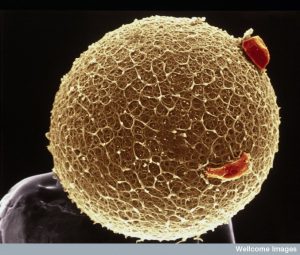So, not all women know that anovulatory cycles are part of every woman’s life. Sometimes we only realize these cycles exist when we start trying to get pregnant. So, what is an anovulatory cycle1, how can you detect it, and what should you do?
What Is an Anovulatory Cycle?
An anovulatory cycle is simply a cycle where the woman does not ovulate. Ovulation happens in the middle of the cycle, during the fertile window. So understanding the day you will ovulate is key to having intercourse on the right days to increase the chances of pregnancy. In a normal 28-day cycle, a woman typically ovulates between the 10th and 17th day of the cycle. In a 30-day cycle, between the 13th and the 20th day. Right after menstruation, progesterone rises, and as the fertile period approaches, there is an increase in estrogen and LH stimulation, which are the hormones that trigger ovulation and the maturation of eggs. Then, ovulation occurs and the luteal phase begins, when progesterone rises and stays high until the next period, or remains elevated if pregnancy has occurred. This happens in an ovulatory cycle, right?
How Does the Anovulatory Cycle Work?
In an anovulatory cycle, these phases don’t exist. LH and Estrogen don’t play their roles, so progesterone takes over the whole cycle, working similarly to when we take birth control pills, with progesterone dominating the entire cycle2.
Symptoms of the Anovulatory Cycle
Anovulation (absence of ovulation) can have some classic, easily identifiable symptoms like white discharge throughout the cycle with no stretchy mucus and no ovarian pains related to ovulation. Those who track their basal temperature can easily spot an anovulatory cycle. Just watch for the changes—since ovulation causes an immediate drop and rise, in an anovulatory cycle this does not happen. The temperature stays at the average without changes like in an ovulatory cycle.
So, detecting an anovulatory cycle can be simple; see, it often changes the expected date of menstruation, in some cases your period continues as normal, but sometimes a delay of 2 or 3 days can occur. Sometimes your period might be late by 10 days or even a month! There is nothing to be done in these cases. But if your period has been delayed for a long time and all the tests are negative, the best thing to do is to see a doctor. If you are trying to get pregnant and want to have more detailed tracking of your cycle and your ovulation3, a great way to help is by using a mobile tracking app, like the Paula App, and using ovulation tests which will indicate if ovulation is approaching, is currently happening, or has already ended, showing when is the right moment to try for a baby and get your positive result faster. The Famivita ovulation test is a good option; you can check out the Famivita products here. There are medications like Provera, for example, which can help bring on menstruation. What’s important if you’re trying to conceive, is to keep your hormone tests up to date. Sometimes an excess of progesterone, or a lack of LH, estrogen, or too much prolactin can lead to a lack of ovulation, which makes pregnancy more difficult. Anovulatory cycles are common, happen to all women, we don’t ovulate in all 12 months of the year, for some this happens more frequently, for others less so, but it’s not a problem, it does not mean you are infertile, sometimes the ovaries just need time to rest. Unless you have a hormone imbalance, outside of that, it is perfectly normal. A kiss and until next time! Also see: How the Menstrual Cycle Works and Its Phases













